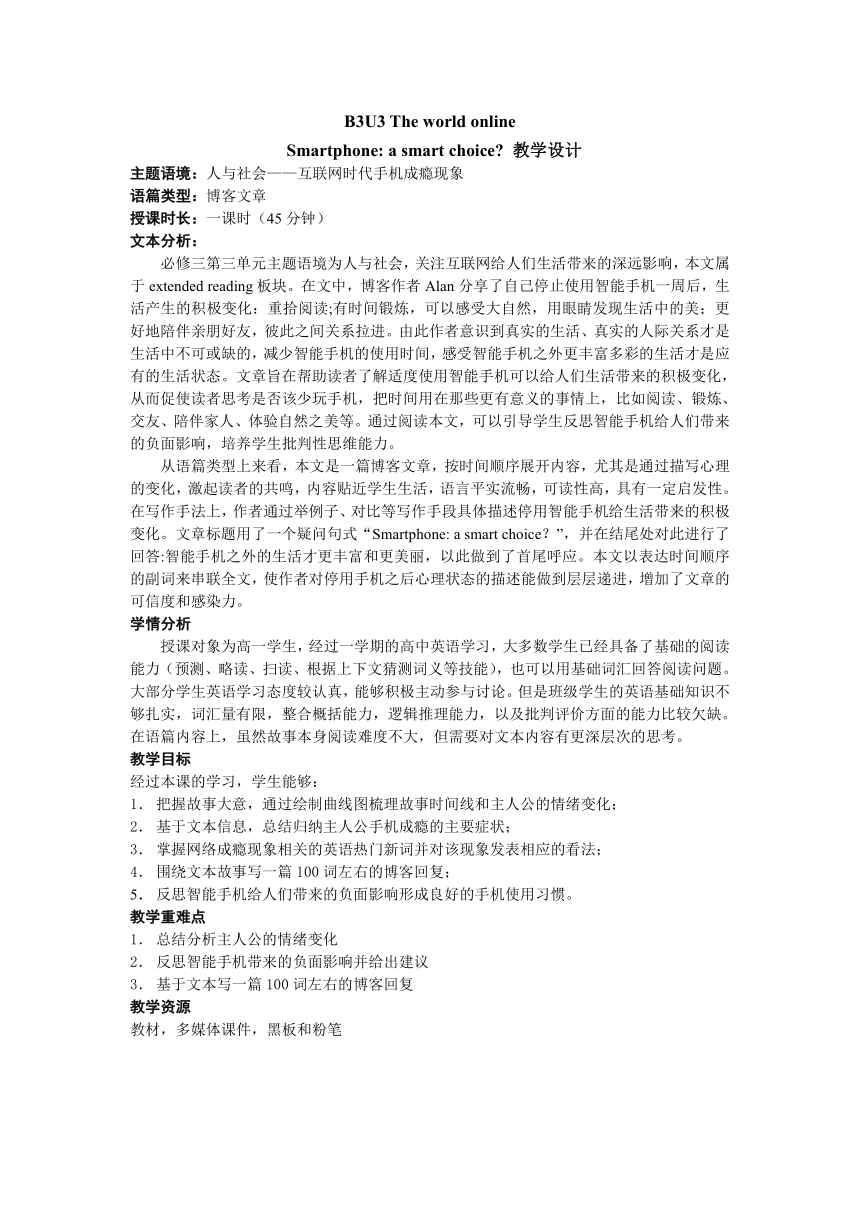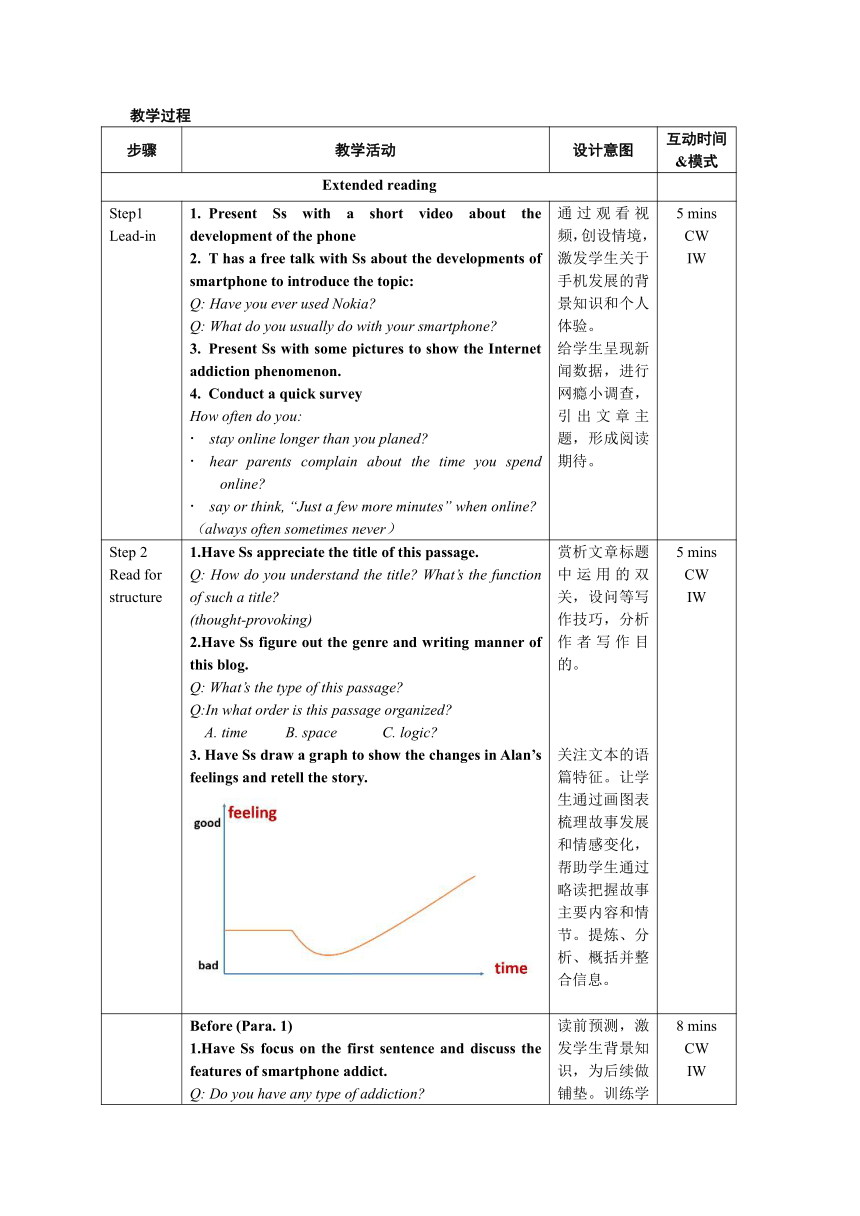英语牛津译林版(2020)必修第三册 Unit 3 The world online Extended reading 教案
文档属性
| 名称 | 英语牛津译林版(2020)必修第三册 Unit 3 The world online Extended reading 教案 |

|
|
| 格式 | docx | ||
| 文件大小 | 63.0KB | ||
| 资源类型 | 教案 | ||
| 版本资源 | 牛津译林版(2019) | ||
| 科目 | 英语 | ||
| 更新时间 | 2021-08-05 23:27:49 | ||
图片预览


文档简介
B3U3
The
world
online
Smartphone:
a
smart
choice?
教学设计
主题语境:人与社会——互联网时代手机成瘾现象
语篇类型:博客文章
授课时长:一课时(45分钟)
文本分析:
必修三第三单元主题语境为人与社会,关注互联网给人们生活带来的深远影响,本文属于extended
reading板块。在文中,博客作者Alan分享了自己停止使用智能手机一周后,生活产生的积极变化:重拾阅读;有时间锻炼,可以感受大自然,用眼睛发现生活中的美;更好地陪伴亲朋好友,彼此之间关系拉进。由此作者意识到真实的生活、真实的人际关系才是生活中不可或缺的,减少智能手机的使用时间,感受智能手机之外更丰富多彩的生活才是应有的生活状态。文章旨在帮助读者了解适度使用智能手机可以给人们生活带来的积极变化,从而促使读者思考是否该少玩手机,把时间用在那些更有意义的事情上,比如阅读、锻炼、交友、陪伴家人、体验自然之美等。通过阅读本文,可以引导学生反思智能手机给人们带来的负面影响,培养学生批判性思维能力。
从语篇类型上来看,本文是一篇博客文章,按时间顺序展开内容,尤其是通过描写心理的变化,激起读者的共鸣,内容贴近学生生活,语言平实流畅,可读性高,具有一定启发性。在写作手法上,作者通过举例子、对比等写作手段具体描述停用智能手机给生活带来的积极变化。文章标题用了一个疑问句式“Smartphone:
a
smart
choice?”,并在结尾处对此进行了回答:智能手机之外的生活才更丰富和更美丽,以此做到了首尾呼应。本文以表达时间顺序的副词来串联全文,使作者对停用手机之后心理状态的描述能做到层层递进,增加了文章的可信度和感染力。
学情分析
授课对象为高一学生,经过一学期的高中英语学习,大多数学生已经具备了基础的阅读能力(预测、略读、扫读、根据上下文猜测词义等技能),也可以用基础词汇回答阅读问题。大部分学生英语学习态度较认真,能够积极主动参与讨论。但是班级学生的英语基础知识不够扎实,词汇量有限,整合概括能力,逻辑推理能力,以及批判评价方面的能力比较欠缺。在语篇内容上,虽然故事本身阅读难度不大,但需要对文本内容有更深层次的思考。
教学目标
经过本课的学习,学生能够:
把握故事大意,通过绘制曲线图梳理故事时间线和主人公的情绪变化;
基于文本信息,总结归纳主人公手机成瘾的主要症状;
掌握网络成瘾现象相关的英语热门新词并对该现象发表相应的看法;
围绕文本故事写一篇100词左右的博客回复;
反思智能手机给人们带来的负面影响形成良好的手机使用习惯。
教学重难点
总结分析主人公的情绪变化
反思智能手机带来的负面影响并给出建议
基于文本写一篇100词左右的博客回复
教学资源
教材,多媒体课件,黑板和粉笔
教学过程
步骤
教学活动
设计意图
互动时间&模式
Extended
reading
Step1
Lead-in
Present
Ss
with
a
short
video
about
the
development
of
the
phone
T
has
a
free
talk
with
Ss
about
the
developments
of
smartphone
to
introduce
the
topic:
Q:
Have
you
ever
used
Nokia?
Q:
What
do
you
usually
do
with
your
smartphone?
Present
Ss
with
some
pictures
to
show
the
Internet
addiction
phenomenon.
Conduct
a
quick
survey
How
often
do
you:
stay
online
longer
than
you
planed?
hear
parents
complain
about
the
time
you
spend
online?
say
or
think,
“Just
a
few
more
minutes”
when
online?
(always
often
sometimes
never)
通过观看视频,创设情境,激发学生关于手机发展的背景知识和个人体验。
给学生呈现新闻数据,进行网瘾小调查,引出文章主题,形成阅读期待。
5
mins
CW
IW
Step
2
Read
for
structure
1.Have
Ss
appreciate
the
title
of
this
passage.
Q:
How
do
you
understand
the
title?
What’s
the
function
of
such
a
title?
(thought-provoking)
2.Have
Ss
figure
out
the
genre
and
writing
manner
of
this
blog.
Q:
What’s
the
type
of
this
passage?
Q:In
what
order
is
this
passage
organized?
A.
time
B.
space
C.
logic?
3.
Have
Ss
draw
a
graph
to
show
the
changes
in
Alan’s
feelings
and
retell
the
story.
赏析文章标题中运用的双关,设问等写作技巧,分析作者写作目的。
关注文本的语篇特征。让学生通过画图表梳理故事发展和情感变化,帮助学生通过略读把握故事主要内容和情节。提炼、分析、概括并整合信息。
5
mins
CW
IW
Step
3
Read
for
contents
and
feelings
Before
(Para.
1)
1.Have
Ss
focus
on
the
first
sentence
and
discuss
the
features
of
smartphone
addict.
Q:
Do
you
have
any
type
of
addiction?
Q:
What
would
a
smartphone
addict
be
like?
2.Have
Ss
find
out
the
symptoms
of
Alan
as
a
smartphone
addict.
Q:
What
symptoms
dis
Alan
have?
Can
you
find
out
the
evidence?
Lack
of
control
No
sense
of
time
Anxiety
Avoidance
of
work/study
Inability
to
sleep
at
night
Feelings
of
guilt
Difficulty
in
maintaining
concentration
Boredom
with
routine
tasks
3.
Have
Ss
summarize
the
feelings
of
Alan
before
quitting
the
habit.
Q:
How
did
Alan
feel
when
he
was
addicted
to
the
phone?
(regretful;
struggling)
Turing
point
(Para.
2)
4.Have
Ss
learn
a
new
buzzword
and
discuss
the
phenomenon.
smombie:
smartphone
zombie
someone
who
is
so
busy
looking
at
their
phone
that
they
ignore
surroundings.
During
(Para.
3)
4.Have
Ss
summarize
the
feelings
of
Alan
at
the
first
day
of
the
quitting.
lost
and
anxious
empty
and
disconnected
5.Have
Ss
learn
2
new
buzzwords
related
to
internet
addiction.
FOMO:
fear
of
missing
out
sth
others
are
experiencing
Q:
Do
you
have
FOMO?
Internet
withdrawal:
the
period
during
which
someone
feels
ill
after
they
have
stopped
using
the
Internet.
6.Have
Ss
summarize
the
feelings
of
Alan
in
the
rest
of
the
week
and
the
reasons.
(free)
Q:
Why
did
Alan
feel
free?
He
had
more
time
to_______________________
He
felt
_________
to
his
friends
and
parents.
7.Have
Ss
focus
on
the
reference.
Line
32:
I
brought
them
up
to
date
with
what
was
going
on
in
my
life.
Q:
What
does
them
refer
to?
8.
Have
Ss
watch
a
story
about
a
smartphone
teenager
and
answer
the
following
questions:
Q:
Why
did
Halley
stop
using
her
phone?
Q:
What
did
she
do
after
staying
away
from
her
phone?
After
(para.6)
9.Have
Ss
answer
the
following
questions.
Q:
What
lessons
has
Alan
learned?
Q:
What’s
Alan’s
answer
to
the
question
“Smartphone:
a
smart
choice?”
(echo)
Q:
Why
did
Alan
write
this
blog?
读前预测,激发学生背景知识,为后续做铺垫。训练学生阅读过程信息搜寻和归纳总结能力,Alan手机上瘾的行为症状进行分析后,引导学生关注故事主人公情感变化这一主线。对阅读文本进行提炼、分析、概括并整合信息。
整合信息,在语境中学习相关词汇
在进行信息加工与处理的过程中,归纳总结情感变化,多角度深度理解文本。
语境中关注词汇和新词的学习,活动中训练思维表达。实现语言和知识的内化的同时,提高阅读效率,增加阅读质量。
通过看一个相关视频,整理提取信息,巩固所学知识。
引导学生关注文本结尾与标题的呼应,作者写作主旨和写作目的。培养阅读策略。
8
mins
CW
IW
3
mins
CW
IW
10
mins
CW
IW
4
mins
CW
IW
Step
4
Critical
thinking
1.Have
Ss
discuss
the
ending
of
the
story.
Q:
Will
they
get?back?to
the
old?bad?habit
when
they
use
the
smartphone
again??
2.Have
Ss
offer
advice
for
Alan.
Q:
Do
you
have
any
advice
for
Alan
to
keep
this
habit?
学生自由讨论故事的结局,实现多维思维的产生和碰撞,鼓励学生表达观点和想法
10
mins
GW
IW
Step
5
homework
Assignments:
Have
Ss
Write
a
comment
of
about
100
words
on
Alan’s
blog
to:
give
him
encouragement
and
advice
tell
your
problem
and
ask
for
advice
基于文本内容,尝试在实际语境中使用语言技能。培养学生写作能力和思维品质。
10
mins
CW
IW
Blackboard
design
Smartphone:
a
smart
choice?
(pun/echo)
备注:
Ss:
Students
T:
Teacher
IW:
individual
work
GW:
group
work
CW:
class
work
The
world
online
Smartphone:
a
smart
choice?
教学设计
主题语境:人与社会——互联网时代手机成瘾现象
语篇类型:博客文章
授课时长:一课时(45分钟)
文本分析:
必修三第三单元主题语境为人与社会,关注互联网给人们生活带来的深远影响,本文属于extended
reading板块。在文中,博客作者Alan分享了自己停止使用智能手机一周后,生活产生的积极变化:重拾阅读;有时间锻炼,可以感受大自然,用眼睛发现生活中的美;更好地陪伴亲朋好友,彼此之间关系拉进。由此作者意识到真实的生活、真实的人际关系才是生活中不可或缺的,减少智能手机的使用时间,感受智能手机之外更丰富多彩的生活才是应有的生活状态。文章旨在帮助读者了解适度使用智能手机可以给人们生活带来的积极变化,从而促使读者思考是否该少玩手机,把时间用在那些更有意义的事情上,比如阅读、锻炼、交友、陪伴家人、体验自然之美等。通过阅读本文,可以引导学生反思智能手机给人们带来的负面影响,培养学生批判性思维能力。
从语篇类型上来看,本文是一篇博客文章,按时间顺序展开内容,尤其是通过描写心理的变化,激起读者的共鸣,内容贴近学生生活,语言平实流畅,可读性高,具有一定启发性。在写作手法上,作者通过举例子、对比等写作手段具体描述停用智能手机给生活带来的积极变化。文章标题用了一个疑问句式“Smartphone:
a
smart
choice?”,并在结尾处对此进行了回答:智能手机之外的生活才更丰富和更美丽,以此做到了首尾呼应。本文以表达时间顺序的副词来串联全文,使作者对停用手机之后心理状态的描述能做到层层递进,增加了文章的可信度和感染力。
学情分析
授课对象为高一学生,经过一学期的高中英语学习,大多数学生已经具备了基础的阅读能力(预测、略读、扫读、根据上下文猜测词义等技能),也可以用基础词汇回答阅读问题。大部分学生英语学习态度较认真,能够积极主动参与讨论。但是班级学生的英语基础知识不够扎实,词汇量有限,整合概括能力,逻辑推理能力,以及批判评价方面的能力比较欠缺。在语篇内容上,虽然故事本身阅读难度不大,但需要对文本内容有更深层次的思考。
教学目标
经过本课的学习,学生能够:
把握故事大意,通过绘制曲线图梳理故事时间线和主人公的情绪变化;
基于文本信息,总结归纳主人公手机成瘾的主要症状;
掌握网络成瘾现象相关的英语热门新词并对该现象发表相应的看法;
围绕文本故事写一篇100词左右的博客回复;
反思智能手机给人们带来的负面影响形成良好的手机使用习惯。
教学重难点
总结分析主人公的情绪变化
反思智能手机带来的负面影响并给出建议
基于文本写一篇100词左右的博客回复
教学资源
教材,多媒体课件,黑板和粉笔
教学过程
步骤
教学活动
设计意图
互动时间&模式
Extended
reading
Step1
Lead-in
Present
Ss
with
a
short
video
about
the
development
of
the
phone
T
has
a
free
talk
with
Ss
about
the
developments
of
smartphone
to
introduce
the
topic:
Q:
Have
you
ever
used
Nokia?
Q:
What
do
you
usually
do
with
your
smartphone?
Present
Ss
with
some
pictures
to
show
the
Internet
addiction
phenomenon.
Conduct
a
quick
survey
How
often
do
you:
stay
online
longer
than
you
planed?
hear
parents
complain
about
the
time
you
spend
online?
say
or
think,
“Just
a
few
more
minutes”
when
online?
(always
often
sometimes
never)
通过观看视频,创设情境,激发学生关于手机发展的背景知识和个人体验。
给学生呈现新闻数据,进行网瘾小调查,引出文章主题,形成阅读期待。
5
mins
CW
IW
Step
2
Read
for
structure
1.Have
Ss
appreciate
the
title
of
this
passage.
Q:
How
do
you
understand
the
title?
What’s
the
function
of
such
a
title?
(thought-provoking)
2.Have
Ss
figure
out
the
genre
and
writing
manner
of
this
blog.
Q:
What’s
the
type
of
this
passage?
Q:In
what
order
is
this
passage
organized?
A.
time
B.
space
C.
logic?
3.
Have
Ss
draw
a
graph
to
show
the
changes
in
Alan’s
feelings
and
retell
the
story.
赏析文章标题中运用的双关,设问等写作技巧,分析作者写作目的。
关注文本的语篇特征。让学生通过画图表梳理故事发展和情感变化,帮助学生通过略读把握故事主要内容和情节。提炼、分析、概括并整合信息。
5
mins
CW
IW
Step
3
Read
for
contents
and
feelings
Before
(Para.
1)
1.Have
Ss
focus
on
the
first
sentence
and
discuss
the
features
of
smartphone
addict.
Q:
Do
you
have
any
type
of
addiction?
Q:
What
would
a
smartphone
addict
be
like?
2.Have
Ss
find
out
the
symptoms
of
Alan
as
a
smartphone
addict.
Q:
What
symptoms
dis
Alan
have?
Can
you
find
out
the
evidence?
Lack
of
control
No
sense
of
time
Anxiety
Avoidance
of
work/study
Inability
to
sleep
at
night
Feelings
of
guilt
Difficulty
in
maintaining
concentration
Boredom
with
routine
tasks
3.
Have
Ss
summarize
the
feelings
of
Alan
before
quitting
the
habit.
Q:
How
did
Alan
feel
when
he
was
addicted
to
the
phone?
(regretful;
struggling)
Turing
point
(Para.
2)
4.Have
Ss
learn
a
new
buzzword
and
discuss
the
phenomenon.
smombie:
smartphone
zombie
someone
who
is
so
busy
looking
at
their
phone
that
they
ignore
surroundings.
During
(Para.
3)
4.Have
Ss
summarize
the
feelings
of
Alan
at
the
first
day
of
the
quitting.
lost
and
anxious
empty
and
disconnected
5.Have
Ss
learn
2
new
buzzwords
related
to
internet
addiction.
FOMO:
fear
of
missing
out
sth
others
are
experiencing
Q:
Do
you
have
FOMO?
Internet
withdrawal:
the
period
during
which
someone
feels
ill
after
they
have
stopped
using
the
Internet.
6.Have
Ss
summarize
the
feelings
of
Alan
in
the
rest
of
the
week
and
the
reasons.
(free)
Q:
Why
did
Alan
feel
free?
He
had
more
time
to_______________________
He
felt
_________
to
his
friends
and
parents.
7.Have
Ss
focus
on
the
reference.
Line
32:
I
brought
them
up
to
date
with
what
was
going
on
in
my
life.
Q:
What
does
them
refer
to?
8.
Have
Ss
watch
a
story
about
a
smartphone
teenager
and
answer
the
following
questions:
Q:
Why
did
Halley
stop
using
her
phone?
Q:
What
did
she
do
after
staying
away
from
her
phone?
After
(para.6)
9.Have
Ss
answer
the
following
questions.
Q:
What
lessons
has
Alan
learned?
Q:
What’s
Alan’s
answer
to
the
question
“Smartphone:
a
smart
choice?”
(echo)
Q:
Why
did
Alan
write
this
blog?
读前预测,激发学生背景知识,为后续做铺垫。训练学生阅读过程信息搜寻和归纳总结能力,Alan手机上瘾的行为症状进行分析后,引导学生关注故事主人公情感变化这一主线。对阅读文本进行提炼、分析、概括并整合信息。
整合信息,在语境中学习相关词汇
在进行信息加工与处理的过程中,归纳总结情感变化,多角度深度理解文本。
语境中关注词汇和新词的学习,活动中训练思维表达。实现语言和知识的内化的同时,提高阅读效率,增加阅读质量。
通过看一个相关视频,整理提取信息,巩固所学知识。
引导学生关注文本结尾与标题的呼应,作者写作主旨和写作目的。培养阅读策略。
8
mins
CW
IW
3
mins
CW
IW
10
mins
CW
IW
4
mins
CW
IW
Step
4
Critical
thinking
1.Have
Ss
discuss
the
ending
of
the
story.
Q:
Will
they
get?back?to
the
old?bad?habit
when
they
use
the
smartphone
again??
2.Have
Ss
offer
advice
for
Alan.
Q:
Do
you
have
any
advice
for
Alan
to
keep
this
habit?
学生自由讨论故事的结局,实现多维思维的产生和碰撞,鼓励学生表达观点和想法
10
mins
GW
IW
Step
5
homework
Assignments:
Have
Ss
Write
a
comment
of
about
100
words
on
Alan’s
blog
to:
give
him
encouragement
and
advice
tell
your
problem
and
ask
for
advice
基于文本内容,尝试在实际语境中使用语言技能。培养学生写作能力和思维品质。
10
mins
CW
IW
Blackboard
design
Smartphone:
a
smart
choice?
(pun/echo)
备注:
Ss:
Students
T:
Teacher
IW:
individual
work
GW:
group
work
CW:
class
work
同课章节目录
- Unit 1 Nature in the balance
- Welcome to the unit
- Reading
- Grammar and usage
- Integrated skills
- Extended reading
- Project
- Unit 2 Natural disasters
- Welcome to the unit
- Reading
- Grammar and usage
- Integrated skills
- Extended reading
- Project
- Unit 3 The world online
- Welcome to the unit
- Reading
- Grammar and usage
- Integrated skills
- Extended reading
- Project
- Unit 4 Scientists who changed the world
- Welcome to the unit
- Reading
- Grammar and usage
- Integrated skills
- Extended reading
- Project
